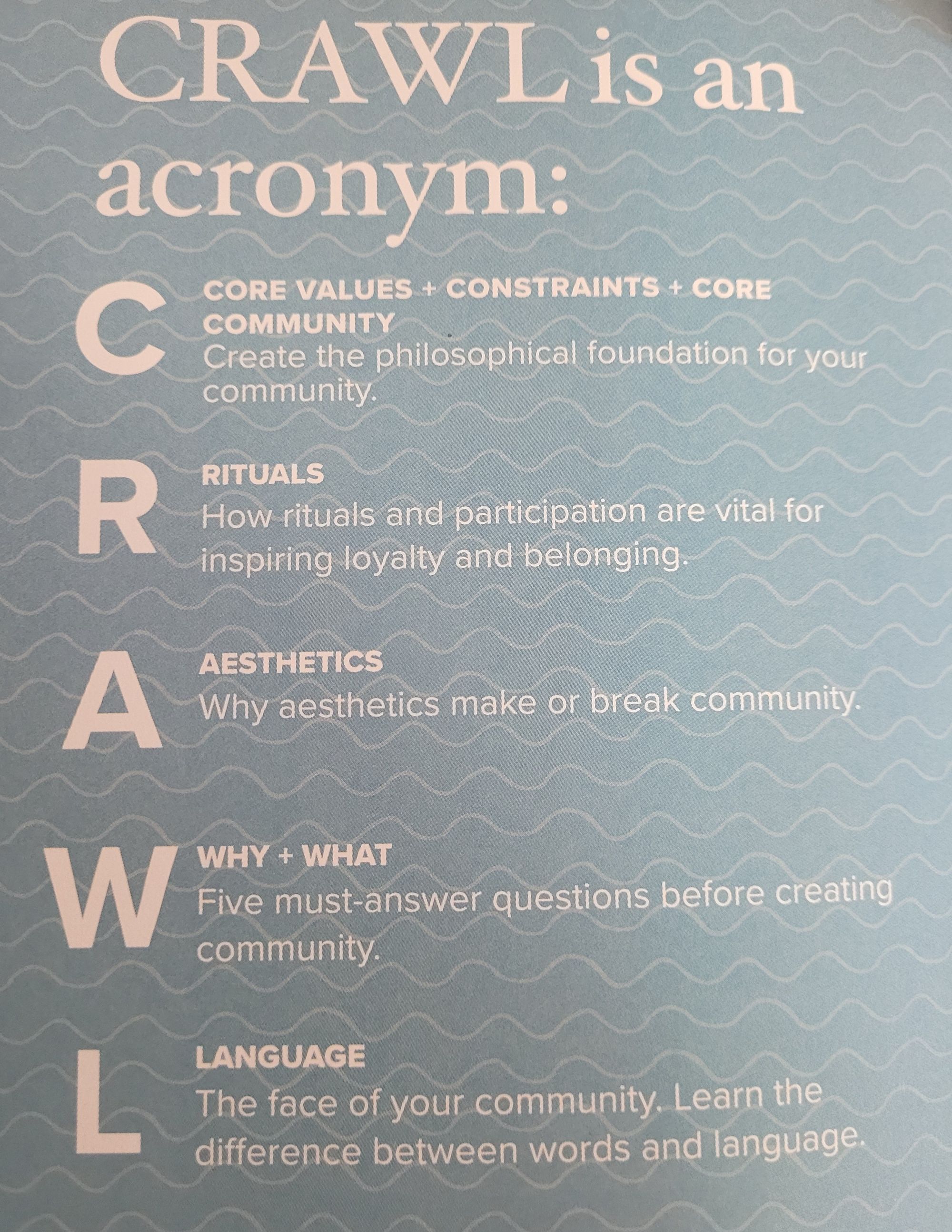Time is a speck of magical pixie dust that makes things amazing when it’s sprinkled. Everything on earth, especially things that are best, takes a lot of time. It takes 21 years for a human to have all 32 teeth; coal takes millions of years to become a diamond; take a child in the mother’s womb, a butterfly in a cocoon; every beautiful thing on earth takes time. A community, without a doubt, is a lovely thing that can come out with bright colors when given its time.
A community takes at least one year to start showing results. This period involves many baby steps that the community accepts and a ton of steps a community builder has to take.
The starting time is genuinely tricky for those who want to nurture a community, so this is how they can go about making sure they put all that they’ve got.
The Divide and Rule policy
The starting gestation period is never less than a year. Now that you have one year in hand, dividing them into 4 (3 months each) will help you make small goals and achieve them effectively.
1st half of the year
The 1st phase (1-3 months)
- Discover each other: When building a community, strangers come together to form the community. You and the members have not yet made a relationship. Every good relationship works out when they get to know each other. In this phase, introduce yourself to the community members and genuinely understand who they are and why they have come to the community. This initial exchange of mutual concern will help you kick-start the running of your community.
- Set right expectations (Delivering the message): All community members join in expecting to gain something, but the community, on the other hand, cannot provide all the expectations of a customer. So telling the members what to expect and what not to expect in the community can eliminate disappointment. Deliver the core value of your community clearly to your members, without which there is hassle everywhere.
- Encourage members to open up: A community without conversation is like a sea without water. Making people open up is not an easy job, and that is why you must do that from the very start. Encourage people who open up; this would make people open up even more and encourage others to open up in the community. Create a safe space where people feel comfortable to put out their thoughts. A community is a diverse space and this group might have introverts who will find it find it hard to hard to open up and get involved, find ways and strategies to bring them together, and use them too. Note: Using icebreaker conversations can help.
- Start Identifying Cohorts: Cohorts are the ones that make your core community. These cohorts will give a hand to you in running the community. To make the running efficient, and the way you expected it to be, select the right people who align with your community’s personality and those who have the ability. These cohorts will serve the duty of advocating for the brand and putting out the members’ issues.
- Experiment: To experiment is something magical. Experimenting has two advantages to it 1. You get to find out what works for your community and your audience. 2. You can try all possible ways, and this might also lead you to find something outstanding. If a community can gain any of this, it sets a path for success in their community. Experiment with the cohorts you have identified by giving them minor tasks and responsibilities. Experiment with multiple things in your community, it’s your time to be crazy creative, so make sure you try anything and everything. To experiment on community platforms will make you build the right foundation for your community for the long run. if you are looking out for something fresh and fun for your community Habitate might interest you.
- Feedback: Now that you have experimented with multiple kinds of stuff in your community. Collect feedback and analyze the feedback you got to see how your feedback is.
- Seeding content: Your community will be starting to get on the phase and it’s time for you to feed their hunger with interesting, enriching values. Injecting content that encourages people to fall in line with the community. The aim of seeding content does not end in guidelines, FAQs, and icebreakers. You get to educate your members by the content you seed, so make it count. Note: Make sure your seeding of content is inflow, posting actively for a period, and then ghosting is not what you want to do.
- Create a feeling of camaraderie: Your community is filled with members, but do they all feel like family? It is of foremost priority that you encourage the feeling of mutual trust and friendship. In the end, this emotional investment people make is what is going to make the community stand high. The peer-to-peer relationship is what makes the community a place where people find joy. If you can create a joyous place, you win.
All these efforts and steps build the foundation for your community when it starts to grow wings.
The 2nd phase (4-6 months)
- Come up with community rituals: We all, part of our family follow rituals, like coming together to have dinners no matter what. When you look back, we are thankful to our parents. It’s the same, a community follows a few things they do and things they don’t. These rituals, at the end of the day, will create an identity for the community. It sets a rhythm to which people relate and tap their feet. People love to be a part of something big, and rituals are those things that are done together. It creates a sense of belonging for a member who is a part of it.
- Find the imbalance to have a balance: A community has to have an imbalance for it to be balanced. A community is a place where a group of people has questions and another group with answers. If the number of people who have answers rises, it will end up in a situation where everyone knows answers, but there’s no one to ask questions. In that case, the community becomes pointless. Ensure there is an imbalance between experts and non-experts. This state makes the entire community a safe space where people come in with questions get answered and the mentors find the joy of helping others.
- Invite new members: The cycle of inviting new members has to be running to fuel the community. Again, numbers don’t matter; a small group can make the world turn, but having another member does give an extra, different perspective, making the community valuable and diverse, so why not make it? It is also super crucial to find the perfect set of people for your community, the right people can do wonders for your community.
- Identify champions and include them: Now that the community is running and there are conversations, you have an excellent opportunity to identify champions who can join your inner circle. The cohorts you identified also will be a prospective set of people who can fall into your champion group. After which, know their abilities and strengths- assign them small responsibilities and include them on your side of the journey. Again, this is very helpful because people and community members will have a higher level of trust when things come out of them rather than the brand itself. Why not make use of it positively which benefits both ends.
- Conduct surveys: Surveys show where you stand. Conduct surveys on two criteria
- Survey to know, how is the improvement
- How new members feel
- Keep a tab on rituals as part of your survey- Your job doesn’t end with you setting rituals. You need to make sure that people follow the rituals and enjoy doing those. This check is vital, cause without this in the right place, your community might not evolve the way you want it to be.
6. Set consistent benchmarks: Before setting benchmarks, it is essential to look into your community guidelines thoroughly. Benchmarks are not a one-time event, but it has to be consistent with small goals set in each. Your community will have OKRs which are broken down by KPIs and these benchmarks make sure you achieve those. Having a benchmark and making sure it is reached will result in constant improvement for the overall aim of your community.
The steps in this phase build the path in which your community will run in the future.
Half year-end
At the end of the first half of the year, there are a few things you need to have a look at to have a well-planned year ahead.
- Analyze what works in the community: In this know the areas where your community has seen a spike, what has been loved by the members, what invited engagement, the type of content that has been appreciated, which of your experiment worked, etc. all this will give you the picture as to where you need to put your net in the next year.
- Understand the sentiment score: Know the emotion that is expressed in your community; after all, feelings are the one that fuels your community.
- The working of the inner circle (champions): Check if the inner circle- your cohorts are working well in solving issues in the community.
- Grow your inner circle: To revamp and evolve your inner circle is much needed in a community. Your community by now will have a lot of new people. When there are more people, you have a tremendous opportunity to increase your inner circle. It is always healthy to bring in a change in the inner circle. This might help cut off the power concentration within the community.
This analysis will help you track where your community is going.
2nd half of the year
The 3rd phase (7- 9 months)
- Set new rituals: Yes, your community has rituals already, but adding in new rituals and bringing a change in rituals will excite the members. In the course of time members will feel bored cause they know what to expect. Set new rituals and experiment with them. When doing so, have in mind what has been liked by your member earlier and try to include that in your rituals.
- Invite new members: To invite new members is a consistent, never-ending process. A new person is a whole new perspective and people make your community rich. And that is why inviting new people to your community can be very enriching for your community.
- Evaluate UGC and brand-induced content: At this phase, your community will start to produce User Generated Content, which is a piece of good news! This will contribute to lowering the hand holding period by the brand. The brand now and then, yes, contributes content, but if the UGC is aligned with the brand’s purpose then that is the best thing that can happen to a community. By this, you build a self-dependent community. If you can create a self-dependent community, you lower the hustle for you and increase consumer experience that’s appreciable. People don’t like to raise tickets; all they want is to solve their problems; if you show them how they can solve it even without your help, they would love it.
- Repurpose content for knowledge base and FAQs: A knowledge base is a library where your members and customers can find all about you and your product. A good knowledge base can increase your customer experience in a good way; a happy customer is all you want. Let the building of your knowledge base be open to all, where the customer, brand, or both together can build it. A knowledge base built collectively is way special to what a brand curates. Look into the UGC and update your FAQs.
- Collect parallel feedback: Collect feedback then and there when you experiment with something to know how it is working for the end-users. This is going to give a hand for you to know what set of things your community members like and what interests them.
- Surveys: Surveys play an essential role in all phases, so conducting the earlier survey will help you know where you stand and how much you’ve grown.
Feedback brings to light the experience the members have in the community and surveys shed light on how your community works.
The 4th phase (10-12 months)
- Peer-to-peer> brand-induced conversation: Let the peer-to-peer dialogue be greater than brand-induced conversation. Peer-to-peer conversion is what makes the community stronger. Peers are straight and truthful. People trust peers more than the brand, and if a peer can tell something positive about the brand, that’s a win for the brand and the member.
- Increase events: Events are a time where people get to meet. Events aggravate the engagement, members’ issues, and the connection members have with the community. When events are done after the community engages, they are even more meaningful on both sides.
In her book ‘belong', Radha Agrawal gives a starter kit for community events involving six steps, which I felt would be of great help when planning to start events for the community. Do check it out it's interesting.
3. Survey: In this stage, survey how the community members make the community use. Knowing this will give you an understanding as to where all your efforts have resulted and will guide you, where to lead in the days to come.
End of the year
- Compare: If its quality over quantity is what you aim for, then comparing the two halves will help you find where your quality has been. Weighing the pros and cons of all your efforts and how well your community has been coping with it will tell you what you can do more and what you need to do less.
- Check if the purpose of your community is met: Knowing the amount the members are happy with will help you decide where to concentrate and what is not working in your community. With this in hand, a brand can predict its future growth. Tracking the score hits at OKRs, KPIs and NPS can tell you if all your efforts have in fulfilling the community’s purpose have been met. After all, a good result in these criteria is what a brand aims for.
- Look at survey feedback: Surveys provide a two-way win, members love when their emotions and opinions are heard, and, a brand tries all ways to know what their customers think about them; a survey serves both these needs. All your surveys are a concentrated form of your community’s emotions and response to all the events and conversations your community held over time.
- Impact: A community impact lies in how the community meets the purpose of the community. For example, if the community’s goal is to solve issues, the number of the problems solved by the community gives the impact the community has created. Knowing the effect it has created will help you estimate its influence in the coming days of a community. Likewise, the development can also be defined by the growth of advocates or the emotion a community member has towards the community. The result can be of any form, and it can differ from each community.
- Award community members: This can be a time where you appreciate the people who have made this community a successful one. Give out specialized awards to your super users, inner circle, active members, contributors, and more. This will not only encourage the award winners but will also nudge the other community members to give their best shot for the community.
When you successfully go through all the pain to make sure all these steps are incorporated into your community. You will start to see the fruit of all the efforts, your job definitely doesn’t end here, but this is a very good kickstart you could give your community to make it run for a long run.
What if things don’t go the way you anticipated?
Concentrated crafting of these ideas into your community will put your community to success, but there is always a chance we mess up, and when that happens this whole time period can be doubled. But fret not because below we have pin-pointed things we might face.
- If guidelines are not set properly the community might be running down a different road.
- When things don’t show results in the areas you wanted but shows result in areas you didn’t want much.
- When the journey of your community is not aligned with your value and tend to move away from it.
- When the culture was not set right
- When the choice of initial members was not right
- When surveys and feedbacks were not looked into soon to take the appropriate action needed.
You certainly didn’t have this in mind. So when cases as such happen, make sure you look into it then and there. If things don’t get resolved the way you wanted, it is not wrong to stop what you’ve been doing and start again. The later you realize, the more time-consuming your community building is going to be.

Making diamonds is not possible in a day; you cannot reach level 100 in a day, you cannot become a grown 50-year-old man the day after you are born. No community can skip these steps and become a thriving community in a day. It is just impossible; a person who understands it nurtures, fertilizes, and builds a sustainable community. So cherish the journey before you, enjoy each step, and make it with care and love, and you will inevitably eat the fruit of it one day.
Radha Agrawal caught my eye and heart with her CRAWL method, where she quotes the process involved in setting a community from scratch.

Knowing that it is time-consuming and using the above divide and rule method to organize your community-building steps will help you taste success in your community. Yes! You need to slowly crawl to reach where you want your community to be. Community building is a process that has to be cherished and enjoyed like a sweet cakewalk. So fall in love with the journey and give your best and see the magic result in and from a community.
Wanna build a community for yourself? Why wait when you got all the knowledge on how to do it? Start now

